| Revision as of 22:49, 14 December 2012 editClueBot NG (talk | contribs)Bots, Pending changes reviewers, Rollbackers6,439,049 editsm Reverting possible vandalism by 64.165.198.12 to version by Barek. False positive? Report it. Thanks, ClueBot NG. (1402285) (Bot)← Previous edit | Revision as of 11:20, 9 January 2013 edit undo98.197.200.120 (talk)No edit summaryNext edit → | ||
| Line 1: | Line 1: | ||
| {{About|the Catholic title of the Virgin Mary as Queen of Heaven|Queen of Heaven in antiquity|Queen of heaven (antiquity)}} | <ref>QUEEN DIGNA D VELASQUEZ</ref>{{About|the Catholic title of the Virgin Mary as Queen of Heaven|Queen of Heaven in antiquity|Queen of heaven (antiquity)}} | ||
| {{redirect|Mary Queen of Heaven|the Catholic parish church|Mary Queen of Heaven (Erlanger, Kentucky)}} | {{redirect|Mary Queen of Heaven|the Catholic parish church|Mary Queen of Heaven (Erlanger, Kentucky)}} | ||
| ]. ], 1645]] | ]. ], 1645]] | ||
Revision as of 11:20, 9 January 2013
This article is about the Catholic title of the Virgin Mary as Queen of Heaven. For Queen of Heaven in antiquity, see Queen of heaven (antiquity). "Mary Queen of Heaven" redirects here. For the Catholic parish church, see Mary Queen of Heaven (Erlanger, Kentucky).
Queen of Heaven is a title given to the Blessed Virgin Mary by Christians mainly of the Roman Catholic Church, and also, to some extent, in Anglicanism and Eastern Orthodoxy, to whom the title is a (disputed) consequence of the First Council of Ephesus in the fifth century, in which the Virgin Mary was proclaimed "theotokos", a title rendered in Latin as Mater Dei, in English as "Mother of God".
The Catholic teaching on this subject is expressed in the papal encyclical Ad Caeli Reginam, issued by Pope Pius XII. It states that Mary is called Queen of Heaven because her son, Jesus Christ, is the king of Israel and heavenly king of the universe. The Eastern Orthodox Churches do not share the Catholic dogma, but themselves have a rich liturgical history in honor of Mary.
The title Queen of Heaven has long been a Catholic tradition, included in prayers and devotional literature, and seen in Western art in the subject of the Coronation of the Virgin, from the High Middle Ages, long before it was given a formal definition status by the Church.
Catholicism
| Part of a series on the |
| Mariology of the Catholic Church |
|---|
 Immaculate Conception by Bartolomé Esteban Murillo (c. 1675) Immaculate Conception by Bartolomé Esteban Murillo (c. 1675) |
| Overview |
| Titles of Mary |
| Prayers and hymns |
| Devotional practices |
Movements and societies
|
| Apparitions |
Key Marian feast days
|
|
|
According to Catholic doctrine, Mary was assumed into heaven and is with Jesus Christ, her divine Son and is represented in Book of Revelation 12 as the woman clothed with the sun who gives birth to Christ. Mary should be called Queen, not only because of her Divine Motherhood of Jesus Christ, her only Son, but also because God the Father has willed her to have an exceptional role in the work of the eternal salvation of humanity. The papal encyclical Ad caeli reginam, argues that as Christ, because he redeemed humankind, is its Lord and king by a special title, so the Blessed Virgin Mary is Queen, on account of the unique manner in which she assisted in the redemption of humanity by giving of her own substance, by freely offering him by her singular desire and petition for, and active interest in, human salvation.
Ad caeli reginam states:
- The main principle on which the royal dignity of Mary rests is without doubt her Divine Motherhood. ... So with complete justice St. John Damascene could write: "When she became Mother of the Creator, she truly became Queen of every creature.".
- Mary was chosen as Mother of Christ in order that she might become a partner in the redemption of the human race.
Mariological basis
See also: Ad Caeli ReginamQueen of Heaven (Latin Regina Caeli) is one of many Queen titles used of the Virgin Mary. The title derived in part from the ancient Catholic teaching that Mary, at the end of her earthly life, was bodily and spiritually assumed into heaven, and that she is there honored as Queen.
The first Mariological definition and basis for the title of Mary Queen of Heaven developed at the Council of Ephesus, where Mary was defined to be the Mother of God. The Council fathers specifically approved this version against the opinion, that Mary is "only" the mother of Jesus. Nobody had participated in the life of her son more, than Mary, who gave birth to the Son of God.
Litany of Loreto
The Litany of Loreto includes several supplications to Mary as Queen. There are two types of statements about the Queen of Heaven.
- Some refer to the Virgin Mary as theological statements about her queenship.
- Others indicate more specifically her realm of influence of the virgin as queen of heaven.
Queen conceived without original sin
Queen conceived without original sin refers to the Immaculate Conception of the Virgin Mary, a long held belief which became dogma in 1854. It definitively solved the question, how Mary, fully human and in need of redemption like everybody else, was granted the fullness of God's grace from her very beginning. The dogma teaches, that Mary, the Mother of God, participated from before her birth in the holiness of God through His grace. She did not become a goddess but being without sin, the spiritual mother and new Eve.
Queen assumed into Heaven
This is the reason she is Queen assumed into Heaven. To Catholics, assumption into heaven refers to the elevation into the heavenly realm, where the saints are with God and his son. Queen assumed into heaven is thus an indication, that Mary's service to the human race was not concluded with the birth of Christ, but continues for all eternity in heaven.
Queen of the Rosary
As Queen of the Rosary, Mary lets the faithful participate in her life with Christ The rosary is a prayer for faith, hope and love, who were all perfected in the Virgin Mary.
Queen of the Angels
In the Catholic tradition as reflected in the Litany of Loreto, angels are messengers of God; angels also praise God. As Mother of God, Mary is more than a messenger and in her Magnificat she praises God. In the heavenly kingdom Mary is seen as Queen of the Angels.
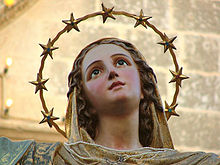
Queen of Peace
To Christians Christ is peace. They pray: "May the peace of Christ be with you" Mary is Queen of Peace, because she aided in the reconciliation of humanity with God like nobody else. With the fullness of her person she aided the entry of peace into this world. She is also considered Queen of Peace, because throughout her life, she lived by God's will and not her own. Peace in the Catholic tradition means to do God's will.
Queen of the Patriarchs
In the Old Testament, patriarchs have an exceptional relation to God. Abraham is even seen as father of the faith (Gen15,5 Rom 4 Hebr 11,8) In the Litany of Loreto, God is not only the God of Abraham, Isaac and Jacob, but also the God of Mary. Only Mary had the complete faith for which she was considered blessed (Luke 1,45) With the title Queen of Patriarchs, the Catholic Church states the continued relevance and position of the Patriarchs of the Old Testament.
Other titles
For similar reasons, Mary, because her prophetic pronouncements in the Magnificat is Queen of Prophets. She is Queen of Apostles, Queen of Martyrs, Queen of Confessors, Queen of Virgins, and Queen of all Saints . As Ever Virgin and immaculate Mother of God who was assumed into heaven, she is closer to God than any other creature
In the classic Roman Catholic Mariology book The Glories of Mary, the author Saint Alphonsus Liguori called the Blessed Virgin Mary the "Gate of Heaven", relying on the writings of Saint Bernard of Clairvaux, another Doctor of the Church.
Other titles have been added to reflect modern scientific understanding. The Second Vatican Council in 1964 referred to Mary as Queen of the Universe. Section 59 of Lumen Gentium, the Dogmatic Constitution on the Church from Vatican II, stated: "Finally, the Immaculate Virgin, preserved free from all guilt of original sin, on the completion of her earthly sojourn, was taken up body and soul into heavenly glory, and exalted by the Lord as Queen of the universe, that she might be the more fully confimed to her Son, the Lord of lords and the conqueror of sin and death." This reference came at a time during which space exploration was beginning.
Feast of Queenship of Mary

Queenship of Mary is a Marian feast day in the liturgical calendar of the Roman Catholic Church, created by Pope Pius XII. On 11 October 1954, the Pontiff pronounced the new feast in his encyclical Ad caeli reginam. The feast was celebrated on May 31, the last day of the Marian month. In 1969, Pope Paul VI moved the feast day to August 22.
The movement to officially recognise the Queenship of Mary was initially promoted by several Catholic Mariological congresses in Lyon, France; Freiburg, Germany; and Einsiedeln, Switzerland. Gabriel Roschini founded in Rome, Italy, an international society to promote the Queenship of Mary, Pro Regalitate Mariae. Several popes had described Mary as Queen and Queen of Heaven, which was documented by Gabriel Roschini. Pope Pius XII repeated the title in numerous encyclicals and apostolic letters, especially during World War II
Veneration
The Catholic faith states, as a dogma, that Mary is assumed into heaven and is with Jesus Christ, her divine son. Mary should be called Queen, not only because of her Divine Motherhood of Jesus Christ, but also because God has willed her to have an exceptional role in the work of eternal salvation. Roman Catholicism employs the liturgical Latin phrase Ora Pro Nobis, meaning pray for us, and does not teach adherents to pray to saints or worship saints, but rather asks those saints to pray for them. The encyclical Ad Caeli Reginam maintains that Christ as redeemer is Lord and King. The Blessed Virgin is Queen, because of the unique manner in which she assisted in our redemption, by giving of her own substance, by freely offering Him for us, by her singular desire and petition for, and active interest. Mary was chosen Mother of Christ so she might help fulfill God's plan in the redemption of humankind; The Catholic Church from the earliest times venerated the Queen of Heaven, according to Pius XII:
- From the earliest ages of the Catholic Church a Christian people, whether in time of triumph or more especially in time of crisis, has addressed prayers of petition and hymns of praise and veneration to the Queen of Heaven and never has that hope wavered which they placed in the Mother of the Divine King, Jesus Christ; nor has that faith ever failed by which we are taught that Mary, the Virgin Mother of God, reigns with a mother's solicitude over the entire world, just as she is crowned in heavenly blessedness with the glory of a Queen.
In the Liturgy of the Hours
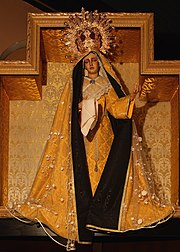
There are four ancient Marian antiphons which express the Queenship of the Virgin Mary: the Salve Regina, the Ave Regina Caelorum, the Alma Redemptoris Mater, and the Regina Caeli. These are prayed at different times of the year as a part of the Liturgy of the Hours, at the end of Compline.
Salve Regina
Main article: Salve ReginaMary as Queen of Heaven is praised in the Salve Regina "(Hail Queen)", which is sung in the time from Trinity Sunday until the Saturday before the first Sunday of Advent. In the vernacular, as a prayer to the Virgin Mary, the Hail Holy Queen is the final prayer of the Rosary. A German Benedictine monk, Hermann of Reichenau (1013-1054), allegedly composed it and it originally appeared in Latin, the prevalent language of the Catholic Church until Vatican II. Traditionally it has been sung in Latin, though many translations exist. These are often used as spoken prayers. In the Middle Ages, Salve Regina offices were held every Saturday. In the 13th century, the custom developed to greet the Queen of Heaven with the Salve Regina, which is considered the oldest of the four Marian antiphons. Several Protestant reformers strongly objected to the Salve and the title Queen of Heaven. As a part of the Catholic Reformation, the Salve Regina was prayed every Saturday by members of the Sodality of Our Lady, a Jesuit Marian congregation.
Ave Regina Caelorum
Main article: Ave Regina CaelorumThe Ave Regina Caelorum (Hail, Queen of Heaven) is an early Marian antiphon, praising Mary, the Queen of Heaven. It is traditionally said or sung after each of the canonical hours of the Liturgy of the Hours. The prayer is used especially after Compline, the final canonical hour of prayer before going to sleep. It is prayed from the Feast of the Presentation (February 2) through the Wednesday of Holy Week. It used to be sung on the feast of the Assumption of Mary. The Ave Regina Caelorum dates back in a different musical intonation to the 12th century. Today's version is slightly different from a 12th century intonation. The Ave Regina Caelorum has four parts: Ave, Salve, Gaude and Vale (in English: hail, rejoice, farewell). It was used for processions in honour of the Queen of Heaven. The Ave Regina Caelorum received numerous musical versions, a famous one of which was composed in 1773 by Joseph Haydn.
Alma Redemptoris Mater
Main article: Alma Redemptoris Mater
The Alma Redemptoris Mater (Loving Mother of our Savior) is recited in the Catholic Church at Compline only from the first Sunday in Advent until the Feast of the Purification (February 2). Continuing theological discussions exist as to the origin and exact timing of this Marian antiphon. It has two equal parts. The Virgin Mary is the loving Mother of the Savior, the ever-virgin with a very high position in heaven. May she listen to her people with mercy in their need for her help. The Latin text is rather short:
- Alma Redemptoris Mater, quae pervia caeli,
- Porta manes, et stella maris, succurre cadenti,
- Surgere qui curat, populo: tu quae genuisti,
- Natura mirante, tuum sanctum Genitorem
- Virgo prius ac posterius, Gabrielis ab ore
- Sumens illud Ave, peccatorum miserere.
Regina Coeli
Main article: Regina CoeliThe Regina Coeli (Queen of Heaven) is an anthem of the Roman Catholic Church which replaces the Angelus at Eastertide (from Holy Saturday until the Saturday after Pentecost). It is named for its opening words in Latin. The Regina Coeli was the subject of numerous intonations throughout the centuries by known and unknown composers. Not all attributions are correct however, as an often quoted Regina Coeli by Joseph Haydn had other authors. Of unknown authorship, the anthem was in Franciscan use in the first half of the 13th century. Together with three other Marian anthems, it was incorporated in the Minorite Roman Curia Office, which the Franciscans soon popularized everywhere, and which by order of Pope Nicholas III (1277–1280) replaced all the older breviaries in the churches of Rome.
Biblical basis
In the New Testament, the title has several biblical sources. Mary is mother of the messianic king. Luke 1:32 says of Jesus, He will be great, and will be called the Son of the Most High; and the Lord God will give to him the throne of his father David. He will rule over the house of Jacob forever and his reign will be without end. It is therefore held in Christianity, that the throne of King David has passed to Jesus. The biblical precedent of ancient Israel is that the mother of the king becomes the queen mother. Since Jesus is the heavenly king, of the lineage of David and Solomon, many see Mary as the queen mother.

The Roman Catholic Church views Mary as the woman clothed with the sun in the Book of Revelation 12:1-3: "1 A great and wondrous sign appeared in heaven: a woman clothed with the sun, with the moon under her feet and a crown of twelve stars on her head. She was pregnant and cried out in pain as she was about to give birth. Then another sign appeared in heaven: an enormous red dragon with seven heads and ten horns and seven crowns on his heads."
For Catholics, the reference to the ark of the covenant immediately prior to this passage(chapter 11, verse 19) confirms the woman's identification with Mary, as she is seen as the ark of the "new covenant" bearing the Word of God (Christ) in her womb, as the old ark carried the Ten Commandments. Catholics interpret Psalm 45, "A Song Celebrating the King's Marriage", as referring to the Messiah, to suggest in verse nine, that Jesus, the Messiah, would have a queen at his right hand. Although Mary was Jesus' mother, she is often portrayed as that queen. Other views are that Psalm 45 refers to the marriage of Jesus to His people, i.e. the church which is called the "Bride of Christ" or that Psalm 45 is simply a celebration upon the marriage of an earthly king, giving thanks to God but not referring to the Messiah. It is also believed by those assigning a special significance to Mary, and believing in her Annunciation, that in Luke 1:26-35 of the New Testament the Archangel Gabriel seems to praise Mary, although she would otherwise be inferior to him.
The Roman Catholic Church generally reasons that the Bible speaks of the mother of Jesus as "a woman clothed with the sun, and the moon under her feet, and on her head a crown of twelve stars" - (Revelation 12:1). As Mary is a perfect model of the Church, she also represents the Church as a whole. Some non-Catholic Bible scholars interpret these verses to refer not to Mary, but rather to Israel or the Church and they do not view Mary as the Queen of Heaven. They reason that the Bible generally refers to nations and tribes as female characters, as in Matthew 2:18 and Revelation 17 and that Jesus is the Alpha and Omega (Revelation 22:13), through Him all things were created (Colossians 1:15-17). However, the Roman Catholic Church accepts Revelation 12 as a reference to Mary, Israel, and the Church as a three-fold symbolism through the Book of Isaiah and affirms Mary as the mother of Jesus as the prophetic fulfilment described in Revelation 12 (cf. Isaiah 7:14, 26:17, 54:1, 66:7). These interpretations have not been resolved within Christianity, and are not necessarily accepted by all denominations.
In the Old Testament the term "queen of heaven" appears in a context unrelated to Mary. The prophet Jeremiah writing circa 628 BC refers to a "queen of heaven" in chapters 7 and 44 of the Book of Jeremiah when he scolds the people for having "sinned against the Lord" due to their idolatrous practices of burning incense, making cakes and pouring out drink offerings to her. This title was probably given to Asherah, a Caananite idol and goddess worshipped in ancient Israel and Judah. For a discussion of "queen of heaven" in the Old Testament, see Queen of heaven (Antiquity).
Art
Main articles: Coronation of the Virgin and Roman Catholic Marian art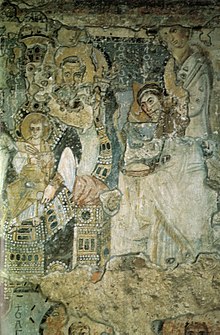
Early Christian art shows Mary in an elevated position. She carries her divine son in her hands, or holds him. After he ascended into heaven, he reigns in divine glory. Mary, his mother, assumed into heaven by her son, participates in his heavenly glory.
The earliest known Roman depiction of Santa Maria Regina depicting the Virgin Mary as a queen dates to the 6th century and is found in the modest church of Santa Maria Antiqua (i.e., ancient St. Mary) built in the 5th century in the Forum Romanum. Here the Virgin Mary is unequivocally depicted as an empress. As one of the earliest Roman Catholic Marian churches, this church was used by Pope John VII in the early 8th century as the see of the bishop of Rome. Also in the 8th century, the Second Council of Nicaea decreed that such pictures of Mary should be venerated.
In the early 16th century, Protestant reformers began to discourage Marian art, and some like John Calvin or Zwingli even encouraged its destruction. But after the Council of Trent in the mid-16th century confirmed the veneration of Marian paintings for Catholics, Mary was often painted as a Madonna with crown, surrounded by stars, standing on top of the world or the partly visible moon. After the victory against the Turks at Lepanto, Mary is depicted as the Queen of Victory, sometimes wearing the crown of the Habsburg empire. National interpretations existed in France as well, where Jean Fouquet painted the Queen of Heaven in 1450 with the face of the mistress of King Charles VII Statues and pictures of Mary were crowned by kings in Poland, France, Bavaria, Hungary and Austria, sometimes apparently using crowns previously worn by earthly monarchs. A surviving small crown presented by Margaret of York seems to have been that worn by her at her wedding to Charles the Bold in 1463. A recent coronation was that of the picture of the Salus Populi Romani in 1954 by Pius XII. The veneration of Mary as queen continues into the 21st Century, but artistic expressions do not have the leading role as in previous times
Artworks, including paintings, mosaics and carvings of the coronation of Mary as Queen of Heaven, became increasingly popular from the 13th century onward. Works follow a set pattern, showing Mary kneeling in the heavenly court, and being crowned either by Jesus alone, or else by Jesus and God the Father together, with the Holy Spitit, usually in the form of a dove, completing the Trinity. The Coronation of Mary is almost entirely a theme of western art. In the Eastern Orthodox Church, although Mary is often shown wearing a crown, the coronation itself never became an accepted artistic subject.
Gallery of art
Paintings
-
 Martino di Bartolomeo, 1400
Martino di Bartolomeo, 1400
-
 Crowning of the Virgin by Rubens, 17th century
Crowning of the Virgin by Rubens, 17th century
-
 The icon Salus Populi Romani, crowned for the Marian year 1954
The icon Salus Populi Romani, crowned for the Marian year 1954
-
 Gregorio di Cecco Enthroned Madonna
Gregorio di Cecco Enthroned Madonna
-
 Crowned Madonna Della Strada
Crowned Madonna Della Strada
-
 Crowned Madonna, Rokitno, Poland, 1671
Crowned Madonna, Rokitno, Poland, 1671
-
 Lorenzo Monaco, Coronation, 1414, Uffizi, Florence
Lorenzo Monaco, Coronation, 1414, Uffizi, Florence
-
 Botticelli, with only God the Father in evidence
Botticelli, with only God the Father in evidence
-
 Pietro Perugino, 1504
Pietro Perugino, 1504
-
 Raphael, 1502-1504
Raphael, 1502-1504
-
 Giacomo di Mino, 1340-1350
Giacomo di Mino, 1340-1350
-
 Giulio Cesare Procaccini, 17th century
Giulio Cesare Procaccini, 17th century
-
 Fra Angelico with a larger court setting
Fra Angelico with a larger court setting
-
 Enguerrand Charonton Coronation of Mary by the Trinity, 1454
Enguerrand Charonton Coronation of Mary by the Trinity, 1454
-
 Botticelli, with only God the Father, 15th century
Botticelli, with only God the Father, 15th century
-
 Lorenzo Costa, Crowning of the Madonna and saints, 1501
Lorenzo Costa, Crowning of the Madonna and saints, 1501
-
 Coronation, Agnolo Gaddi, 14th century
Coronation, Agnolo Gaddi, 14th century
-
 Jean Fouquet, Coronation of the Virgin, 15th century
Jean Fouquet, Coronation of the Virgin, 15th century
-
 , 1441
, 1441
-
 Paolo Veneziano, 1324
Paolo Veneziano, 1324
-
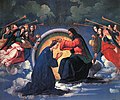 Ridolfo Ghirlandaio, 1504
Ridolfo Ghirlandaio, 1504
-
 Gentile da Fabriano, 1422-1425
Gentile da Fabriano, 1422-1425
-
 Fra Angelico, 1434-1435
Fra Angelico, 1434-1435
-
 Rubens, 1609
Rubens, 1609
Statues
-
 Crowned statue in Porto Alegre, Brazil
Crowned statue in Porto Alegre, Brazil
-
Crowned Virgin of Carmel, Varallo Sesia, Italy
-
 Crowned statue of the Blessed Virgin, Spain
Crowned statue of the Blessed Virgin, Spain
Frescoes
-
 Tetmajer Madonna in Heaven, 1895
Tetmajer Madonna in Heaven, 1895
-
 Scheffler, Queen of Heaven, Regensburg, Germany
Scheffler, Queen of Heaven, Regensburg, Germany
-
 Scheffler, Crowned Virgin
Scheffler, Crowned Virgin
-
 El Escorial Monastery Spain
El Escorial Monastery Spain
-
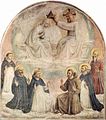 Fra Angelico, Florence, 1437-1446
Fra Angelico, Florence, 1437-1446
-
 Church of Sant'Angelo, Milan
Church of Sant'Angelo, Milan
-
 Salzburg, 1697–1700
Salzburg, 1697–1700
-
 Aldo Locatelli, 20th century, Brazil
Aldo Locatelli, 20th century, Brazil
Altars
-
 Coronation of the Virgin, Bartolo di Fredi, 1388
Coronation of the Virgin, Bartolo di Fredi, 1388
-
 Gentile da Fabriano Altarpiece
Gentile da Fabriano Altarpiece
-
 18th century German altar
18th century German altar
-
 19th century German altar
19th century German altar
See also
Template:Misplaced Pages books
- Hail Mary
- Lady of Sorrows
- Madonna of humility
- Mother of the Church
- Mother of God
- Mother of Mercy
- Seat of Wisdom
References
- QUEEN DIGNA D VELASQUEZ
- "Encyclical Ad Caeli Reginam". Vatican.
- ^ Saunder, Rev. William (2004).Woman Clothed with the Sun.Arlington Catholic Herald. Catholic Education Resource Center. Retrieved July 6, 2011.
- Ad caeli reginam, 37
- Ad caeli reginam 34
- Ad caeli reginam, 38
- Dictionary of Mary, Catholic Book Publishing Co., New York, 1985, p283-284
- Tschochner, Königtum Mariens Marienlexikon, 590
- ^ Fastenrath, Kirchenlexikon, 592
- Pope Benedict XVI May 3, 2008 .
- Litany of Loreto
- Saint Alphonsus Liguori, The Glories of Mary, Liguori Publications, 2000, ISBN 0-7648-0664-5
- Lumen Gentium, Chapter 8, Section 59.
- Tschochner 591
- AAS 1942, 126,
- AAS 1942 315,
- AAS 1943, 248,
- AAS 1943 38,
- AAS 1946,266,
- AAS 1950, 763,
- AAS 1950 774.
- Ad Caeli Reginam 38
- Ad caeli reginam 1
- Marienlexikon, 648
- C Bernt Marienlexikon 321
- Bernt, Marienlexikon, 321
- ^ Haydn,in Marienlexikon, 88
- Marienlexikon, 104
- Catholic encyclopedia
- Taylor Marshall, The Crucified Rabbi: Judaism and the Origins of Catholic Christianity, Saint John Press, 2009 ISBN 978-0-578-03834-6 page 41
- Kallinikos 598
- Biblegateway Jeremiah
- Erik Thunø, 2003 Image and relic: mediating the sacred in early medieval Rome ISBN 88-8265-217-3 page 34
- Bissera V. Pentcheva, 2006 Icons and power: the Mother of God in Byzantium ISBN 0-271-02551-4 page 21
- Anne J. Duggan, 2008 Queens and queenship in medieval Europe ISBN 0-85115-881-1 page 175
- Tschochner 590
- Marienlexikon 595
- ^ Marienlexikon 596
- Dictionary of Mary, Catholic Book Publishing Co., New York, 1985
- The Catholic Encyclopedia, 1912.
| Mary, mother of Jesus | |||||||||||||||
|---|---|---|---|---|---|---|---|---|---|---|---|---|---|---|---|
| Family |  | ||||||||||||||
| Life |
| ||||||||||||||
| Mariology |
| ||||||||||||||
| Veneration |
| ||||||||||||||